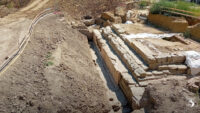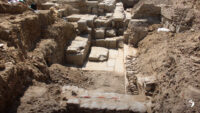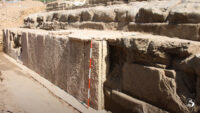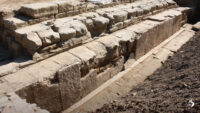 A Roman temple has been discovered in the town of Sarsina in the northern Italian region of Emilia Romagna. Excavations have uncovered the remains of a large quadrangular structure dating to the 1st century B.C. Massive horizontal lines of cut sandstone blocks, coeval with the sandstone slab flooring of the nearby forum, formed the podium on which the ancient temple once stood. Those walls are gone now, but the cut stone bases are in excellent condition, with more than nine feet of height still preserved.
A Roman temple has been discovered in the town of Sarsina in the northern Italian region of Emilia Romagna. Excavations have uncovered the remains of a large quadrangular structure dating to the 1st century B.C. Massive horizontal lines of cut sandstone blocks, coeval with the sandstone slab flooring of the nearby forum, formed the podium on which the ancient temple once stood. Those walls are gone now, but the cut stone bases are in excellent condition, with more than nine feet of height still preserved.
 Sarsina was a settlement of the Italic Umrbi people. It was conquered by Lucius Cornelius Scipio (grandfather of the Scipio who would finally defeat Carthage in the Second Punic War) around 266 B.C. Fifteen years later, Sarsina’s most famous son — the comedic playwright Titus Maccius Plautus — was born there. When it became a Roman municipium in the middle of the 1st century B.C., it was reorganized and rebuilt according to Roman urban principles. A new defensive wall was built at that time, and the new temple as well.
Sarsina was a settlement of the Italic Umrbi people. It was conquered by Lucius Cornelius Scipio (grandfather of the Scipio who would finally defeat Carthage in the Second Punic War) around 266 B.C. Fifteen years later, Sarsina’s most famous son — the comedic playwright Titus Maccius Plautus — was born there. When it became a Roman municipium in the middle of the 1st century B.C., it was reorganized and rebuilt according to Roman urban principles. A new defensive wall was built at that time, and the new temple as well.
 The archaeological investigation of the temple site indicates that it was dedicated to the Capitoline Triad, the gods Jupiter, Juno and Minerva. Many cities in Italy had Capitolia, mirroring the first one built on the Capitoline Hill (hence the name) in Rome. They were often built on a high point of the town, as is the case here. The temple’s remains consist of the podium clad in marble slabs and a water drainage system, but there is evidence there was an earlier temple of the Umbri at the site dating to the 4th century B.C.
The archaeological investigation of the temple site indicates that it was dedicated to the Capitoline Triad, the gods Jupiter, Juno and Minerva. Many cities in Italy had Capitolia, mirroring the first one built on the Capitoline Hill (hence the name) in Rome. They were often built on a high point of the town, as is the case here. The temple’s remains consist of the podium clad in marble slabs and a water drainage system, but there is evidence there was an earlier temple of the Umbri at the site dating to the 4th century B.C.
 Excavations are ongoing. The front of the temple has yet to emerge. Archaeologists hope to find the remains of the front staircase to the podium and the marble pavement. Plans for a new sports facility with adjoining shopping center at the site are currently suspended while the archaeological investigation continues.
Excavations are ongoing. The front of the temple has yet to emerge. Archaeologists hope to find the remains of the front staircase to the podium and the marble pavement. Plans for a new sports facility with adjoining shopping center at the site are currently suspended while the archaeological investigation continues.
* This article was originally published here










No comments:
Post a Comment